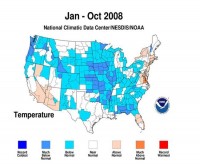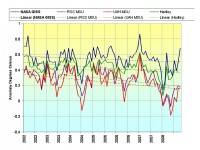Nov 12, 2008
Hadley’s Phil Jones Whistling Past the Graveyard
Comments by Joe D’Aleo on Reuter’s story
2008 Set to be About 10th Warmest Year
By Alister Doyle, Reuters Environment Correspondent
This year is on track to be about the 10th warmest globally since records began in 1850 but gaps in Arctic data mean the world may be slightly underestimating global warming, a leading scientist said on Tuesday. A natural cooling of the Pacific Ocean known as La Nina kept a lid on temperatures in 2008 despite an underlying warming trend, said Phil Jones, director of the Climatic Research Unit at the University of East Anglia in England.
“This year is about 10th,” he told Reuters in a telephone interview. “La Nina in the Pacific lasted longer than we envisaged.” Jones’s unit is one of the main sources of global climate data for the United Nations. The warmest year on record was 1998, followed by 2005 and 2003, with other years this century closely bunched. Tenth place would make 2008 the least warm since 1999. The update marginally cools an estimate from January, when Jones’s unit and the British Met Office (Britain’s meteorological service) estimated that 2008 would be “another top 10 year,” near the bottom of the ranking.
The U.N. Climate Panel says human emissions of greenhouse gases, mainly from burning fossil fuels, are blanketing the planet. Rising temperatures will bring more floods, heatwaves, more powerful storms and rising sea levels, it says.
Jones said temperature records may fractionally underestimate warming because of gaps in measurements in the Arctic for 1961-90, the benchmark years for judging change, and problems in verifying ocean temperatures. “The world is probably a little warmer than we are measuring,” he said. Read more here of Jones spinning more tales.
Icecap Note: Recall it was Jones early in January 2007 who warned 2007 would be the warmest year on record and 2008 would surely end up top ten. At the risk of sounding like Andy Rooney, did you ever notice how they are always trying to find more warmth by finding proof that the high tropical atmosphere or ocean temperatures were measured wrong or find surrogates that prove it was cooler before and warmer now. How about looking at the known warm biases that dwarf these adjustments like a 66% station dropout, tenfold increase in missing data, little or no urbanization or land use change adjustment based on flawed science, no adjustments for changing from whitewash to latex paints for shelters or to new hygrometers with a known warm bias and bad siting. Even here in the US, recall Anthony Watts’ band of volunteers have found only 4% of the nearly 600 stations surveyed thus far met the government’s standards for ideal siting and 69% were poorly or very poorly sited. Why isn’t the same kind of attention paid to finding and correcting those errors.
The answer to that rhetorical question is that like at least half a dozen peer reviewed papers have shown, that would show that the warming is up to 50% exaggerated and that this might only be a top 20 or 30 warmest year. NOAA and NASA GISS are no better. Only the satellite data can be trusted but unfortunately it only goes back to 1979. NOAA (Karl and Petersen), NASA (Hansen and Schmidt), Hadley (Jones) have thrived on budgets fattened by the global warming issue. They have won the lottery and will do whatever it takes to keep the annuity checks coming.
Jones blamed El Nino and La Nina and a quiet sun for the cooling. A big step forward. But what he doesn’t realize that given the switch to a cool PDO, there will be more cooling La Ninas which with a sun going into a 200 year Dalton Minimum like slumber, will ensure the cooling continues. Download post here.
Nov 11, 2008
Year Thus Far Cold, Hansen Up to Old Shenanigans in October
By Joseph D’Aleo
NOAA shows the first ten months of the year were cold over many areas of the country from the Northwest to the Central States. Above normal temperatures were confined to sections of the east and southwest.

See larger image here
October was a cold month in many areas of the east and central states. For the nation as a whole, the average October temperature of 54.5 degrees F was 0.3 degree F below the 20th Century average, based on preliminary data.

See larger image here
Globally October in most data bases maintained about the same level as September with one glaring exception, Hansen’s NASA GISS. There may be a second high value in the next few weeks, NOAA GHCN shares many of the same data points and adjustments or lack thereof will probably come in on the high side. Hadley Centre also will not report also for another week. It has remained more in line with the satellite in recent years.
The data bases all have different base periods, which contribute to the relative differences. NASA uses the coldest base period 1951 to 1980, Hadley the second coldest 1961 to 1990, UAH and RSS MSU the warmest 1979 to 1998.
It was mild in parts of southeast Europe and Asia in October. The arctic ice developed at a record pace in October, but snowcover was slow to increase until the last week. It has now quickly expanded to just above the normal for the hemisphere for the date. See latest plots of FSU snow data for the date here.
The plot of temperatures since 2002 is remarkable for the departures shown. NASA GISS is a full degree F warmer than the satellite measurements, which continue the downtrend of 0.2C since 2002. Even with the bogus warmth, GISS depicts a small downtrend.

See larger image here
See this Watts Up With That guest post by John Goetz and read the interesting comments on Hansen’s folly. He provides the following update:
Update: Thanks to an email from John S. - a patron of climateaudit.org - we have learned that the Russian data in NOAA’s GHCN v2.mean dataset is corrupted. For most (if not all) stations in Russia, the September data has been replicated as October data, artificially raising the October temperature many degrees. GISS has corrected that data but meanwhile found more compensating warmth in the arctic, Canada and Australia (late data arrival). The reduction was only to +0.68C See more here. See also coverage of this NOAA/NASA error at Climate Audit here.
Nov 10, 2008
The Sun Shows Signs of Life—Sort Of
By David Hathaway, NASA
After two-plus years of few sunspots, even fewer solar flares, and a generally eerie calm, the sun is finally showing signs of life. “I think solar minimum is behind us,” says sunspot forecaster David Hathaway of the NASA Marshall Space Flight Center.
His statement is prompted by an October flurry of sunspots. “Last month we counted five sunspot groups,” he says. That may not sound like much, but in a year with record-low numbers of sunspots and long stretches of utter spotlessness, five is significant. “This represents a real increase in solar activity.”

New-cycle sunspot group 1007 emerges on Halloween and marches across the face of the sun over a four-day period in early November 2008. Credit: the Solar and Heliospheric Observatory (SOHO). See larger image here
Even more significant is the fact that four of the five sunspot groups belonged to Solar Cycle 24, the long-awaited next installment of the sun’s 11-year solar cycle. “October was the first time we’ve seen sunspots from new Solar Cycle 24 outnumbering spots from old Solar Cycle 23. It’s a good sign that the new cycle is taking off.” Old Solar Cycle 23 peaked in 2000 and has since decayed to low levels. Meanwhile, new Solar Cycle 24 has struggled to get started. 2008 is a year of overlap with both cycles weakly active at the same time. From January to September, the sun produced a total of 22 sunspot groups; 82% of them belonged to old Cycle 23. October added five more; but this time 80% belonged to Cycle 24. The tables have turned.
At first glance, old- and new-cycle sunspots look the same, but they are not. To tell the difference, solar physicists check two things: a sunspot’s heliographic latitude and its magnetic polarity. (1) New-cycle sunspots always appear at high latitude, while old-cycle spots cluster around the sun’s equator. (2) The magnetic polarity of new-cycle spots is reversed compared to old-cycle spots. Four of October’s five sunspot groups satisfied these two criteria for membership in Solar Cycle 24.
The biggest of the new-cycle spots emerged at the end of the month on Halloween. Numbered 1007, or “double-oh seven” for short, the sunspot had two dark cores each wider than Earth connected by active magnetic filaments thousands of kilometers long. Amateur astronomer Alan Friedman took this picture from his backyard observatory in Buffalo, New York:

On Nov. 3rd and again on Nov. 4th, double-oh seven unleashed a series of B-class solar flares. Although B-flares are considered minor, the explosions made themselves felt on Earth. X-rays bathed the dayside of our planet and sent waves of ionization rippling through the atmosphere over Europe. Hams monitoring VLF radio beacons noticed strange “fades” and “surges” caused by the sudden ionospheric disturbances.
Hathaway tamps down the excitement: “We’re still years away from solar maximum and, in the meantime, the sun is going to have some more quiet stretches.” Even with its flurry of sunspots, the October sun was mostly blank, with zero sunspots on 20 of the month’s 31 days. But it’s a start.
See more here.
Icecap Note: This was less bullish than the release from late 2006 when Hathway first announced the arrival of cycle 24.
Nov 07, 2008
Sunlight Has More Powerful Influence on Ocean Circulation and Climate than North American Ice Sheets
Physorg.com
A study reported in today’s issue of Nature disputes a longstanding picture of how ice sheets influence ocean circulation during glacial periods. The distribution of sunlight, rather than the size of North American ice sheets, is the key variable in changes in the North Atlantic deep-water formation during the last four glacial cycles, according to the article. The new study goes back 425,000 years, according to Lorraine Lisiecki, first author and assistant professor in the Department of Earth Science at the University of California, Santa Barbara.
Lisiecki and her co-authors studied 24 separate locations in the Atlantic by analyzing information from ocean sediment cores. By observing the properties of the shells of tiny marine organisms, called foraminifera, found in these cores, they were able to deduce information about the North Atlantic deep water formation. Scientists can discern historical ocean temperature and circulation patterns through the analysis of the chemical composition of these marine animals.
Previously, scientists relied on a study called “Specmap,” performed in 1992, to find out how different parts of the climate system interacted with one another during glacial cycles. Specmap analyzed ocean circulation at only one place in the Atlantic. “What I found was that the one site that the Specmap study used actually didn’t match most of the other sites in the Atlantic,” said Lisiecki. “They just happened to have a strange site that didn’t behave like most of the other sites. The other sites show that the circulation is not responding to the ice volume, but that it is responding to changes in the distribution of sunlight.”
Previously, scientists believed that deep ocean circulation, the amount of water formed in the North Atlantic that goes into the deep ocean, varied or responded according to the amount of ice volume in the Northern Hemisphere. The prevailing idea was that when ice ages occur, with large sheets of ice over North America, the amount of North Atlantic deep water is reduced. That’s an important part of circulation,” said Lisiecki. “The Gulf Stream brings up warm water from the tropics and that water is turned into this North Atlantic deep water that then sinks and moves southward at depth so you have a cycle. Warm water moves northward and then cools and sinks. That’s the North Atlantic deep water formation process.”
When warm water in the Gulf Stream comes north, it brings heat to the North Atlantic and Europe and then sinks in the North Atlantic and flows back southward at a depth of 3,000 meters. “This is fairly important for the climate because it brings this heat northward,” said Lisiecki. “The Specmap study in 1992 found that circulation is reduced when you have large ice sheets, presumably because you have less of this North Atlantic deep water forming. Our results show that this is not always true.”
She explained that the new data changes our understanding about how the different parts of the climate system are interacting with one another and in particular the influence of the ice sheets on climate. “Because the ice sheets are so large, it was a nice simple story to say that they were having the predominant influence on all the parts of the climate system,” said Lisiecki. “But our study showed that this wasn’t the only important part of the changes in climate. The distribution of sunlight is the controlling factor for North Atlantic deep water formation.
Nov 07, 2008
Hard Lesson about Solar Realities for NOAA / NASA
By Warwick Hughes with input from David Archibald
The real world sunspot data remaining quiet month after month are mocking the curved red predictions of NOAA and about to slide underneath. Time for a rethink I reckon NOAA !! Here is my clearer chart showing the misfit between NOAA /NASA prediction and real-world data. Regular readers might remember that we started posting articles drawing attention to contrasting predictions for Solar Cycle 24, way back on 16 December 2006. Then in March 2007 I posted David Archibald’s pdf article, ”The Past and Future of Climate”. I would like to see another version of David’s Fig 12 showing where we are now in the transition from Cycle 23 to Cycle 24. Solar Cycle 24 Prediction Issued April 2007 from NOAA /NASA.

See larger image here
David provided several new graphics. The first compares Solar Cycle 23 to the minima of the late 20th century and the late 19th and early 20th century. Note the similarity to the older cycles in the current cycle.

See larger image here
David has a bit of fun with this graphic which is aligned on the previous solar minimum. Solar Cycles 3 and 4 prior to the Dalton Minimum had very similar shapes and amplitudes to Solar Cycles 22 and 23.

See larger image here
See the full post and all the graphics here.
|










